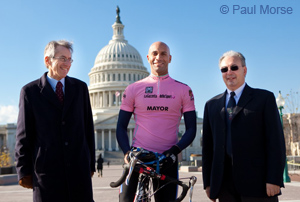 International Cycling Union (UCI) president Pat McQuaid has weighed in on Giro d’Italia race director Angelo Zomegnan’s initiative to hold the start of the Italian Grand Tour in Washington D.C. The Irishman’s greatest concern is for the Giro organizers to keep the riders’ safety in mind, and points out the debacle at the “Milan Show” stage of the Giro d’Italia as Zomegnan over stepping those bounds.
International Cycling Union (UCI) president Pat McQuaid has weighed in on Giro d’Italia race director Angelo Zomegnan’s initiative to hold the start of the Italian Grand Tour in Washington D.C. The Irishman’s greatest concern is for the Giro organizers to keep the riders’ safety in mind, and points out the debacle at the “Milan Show” stage of the Giro d’Italia as Zomegnan over stepping those bounds.
“Bringing in extreme events brings more publicity for the sport, but he [Zomegnan] goes a little too far in creating a spectacle and he neglects the sporting element and the safety of the riders,” McQuaid told the New York Times last week.
The circuit race scheduled in this year’s Giro d’Italia was designed to celebrate the 100th Anniversary of the race, taking the peloton on a circuit through the city streets of Milan. The riders ended up protesting the stage because they believed the racing conditions were too dangerous, with only the sprinter’s teams contesting the finish in the final kilometers.
“The course requires explosive power and riders to get their butts out of the saddle,” said an angry Zomegnan at the time. “Apparently, some older riders have no desire to do so. Instead, it seems as their legs are shorter while their tongues have become longer.”
While Zomegnan didn’t agree with the rider’s decision, he realized that the best thing for the race was to work out a compromise and move on. The Italian believed that the peloton was still in a bit of shock after the horrific fall of Pedro Horrillo (Rabobank) the previous day, and commented that the “Milan Show” stage would not have been an issue had that unrelated incident not occurred.
Chief among the complaints from the riders last May were the parked cars along the course, narrow turns, and railway tracks just before the finish line. Zomegnan blamed an “older rider” for starting the demonstration, which was believed to be directed at seven-time Tour de France winner Lance Armstrong, and maintained that the course was safe for the cyclists.
McQuaid obviously disagreed saying last week, “I understand his position of trying to create public interest, but this can’t go on. If the Giro idea becomes realistic, we would definitely have a say in the structure of the race. We would make sure to protect the riders.” He suggested two to three days of rest in Italy for the riders to recover from the jet lag caused by a Trans-Atlantic flight.
But organizers disagree with the UCI president and believe that traveling across the Atlantic will have less of an impact on the athletes. “Normal people have jet lag,” Zomegnan told the paper last week. “Normal people can’t run three weeks and 3,500 kilometers. The riders aren’t normal people.”
Typically the Grand Tours have two rest days spread over the course of the three-week race, and it looks like organizers will have to rethink their schedule if they plan to keep the UCI happy with their plans.
Both Lance Armstrong and Christian Vande Velde have weighed in favorably on the proposed Giro d’Italia start in America’s capital city, with the latter showing a concern for the logistics telling the New York Times, “But, of course, there’s a fine line between crazy stupid and crazy spectacular.”
Zomegnan seems determined to make this work, saying before his meeting with D.C. Mayor Adrian M. Fenty last week, “Is it crazy? Oh sure, yes, I’ve heard that,” he said. “But I think it is good to take chances. I don’t say, why? I say, why not?”
Mark Sommers, who is a part of the working group in charge of bringing the race to D.C., was also optimistic about the task at hand telling VeloNation last week, “We have a tentative agreement [with the Giro organizers], and we have agreed on the large conceptual ideas.”